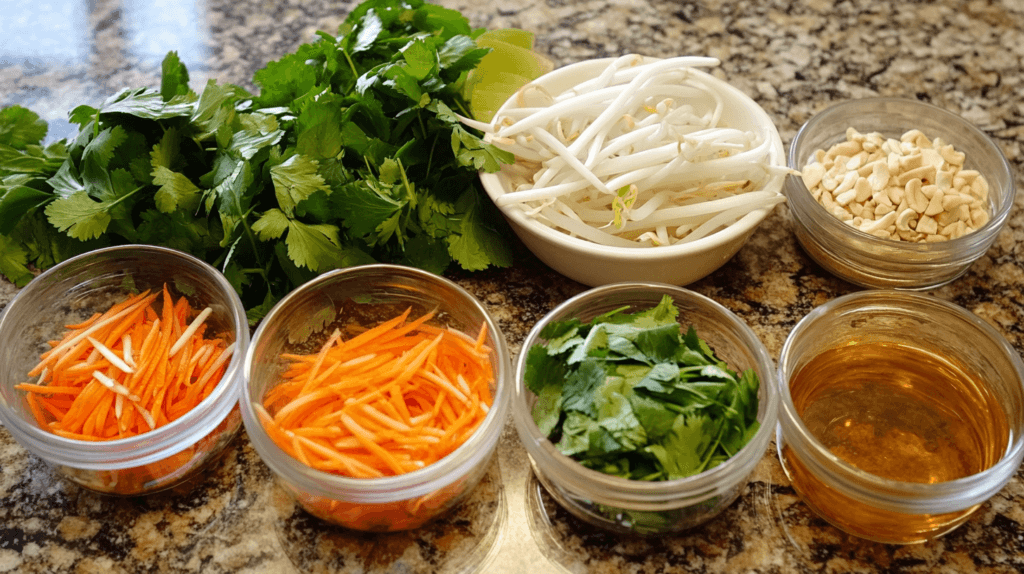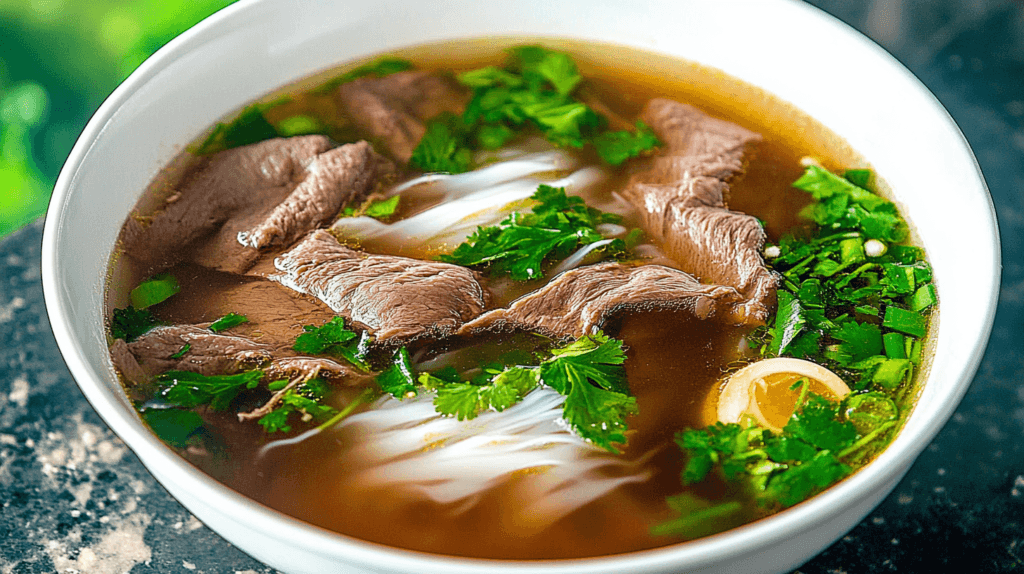Pho is one of Vietnam’s most beloved dishes, known for its aromatic broth, tender meats, fresh herbs, and rice noodles. It’s a staple in Vietnamese cuisine and has gained global popularity for its comforting and nourishing qualities. However, for those with gluten sensitivities, celiac disease, or a preference for gluten-free foods, a crucial question arises: Is pho gluten-free?
While traditional pho may seem safe due to its rice-based noodles, hidden sources of gluten can sometimes make this dish unsafe for people with gluten intolerance. From broths thickened with wheat-based additives to sauces containing gluten, there are several factors to consider before indulging in a bowl of pho.
In this guide, we’ll break down whether pho is truly gluten-free, what ingredients to watch out for, and how to enjoy this delicious dish without any risks.
Table of Contents
Understanding Pho

What is Pho?
Pho (pronounced “fuh”) is a Vietnamese noodle soup that typically consists of a flavorful broth, rice noodles, protein (such as beef or chicken), and a variety of fresh garnishes like bean sprouts, lime, basil, and chili peppers. It is often served with condiments such as hoisin sauce and sriracha.
This dish has a deep cultural significance in Vietnam, originating in the early 20th century. Over time, it has evolved with regional variations and has become a global favorite.
Common Ingredients in Pho
A traditional bowl of pho usually includes:
- Rice noodles (Bánh phở) – Made from rice flour and water, these are naturally gluten-free.
- Broth – Prepared by simmering beef or chicken bones with spices like star anise, cinnamon, and ginger.
- Protein – Common options include beef (Pho Bo), chicken (Pho Ga), or tofu for vegetarian versions.
- Herbs and vegetables – Basil, cilantro, green onions, and bean sprouts.
- Condiments – Hoisin sauce, fish sauce, soy sauce, sriracha, and chili paste (some of these may contain gluten).
While these ingredients seem naturally gluten-free, certain hidden elements may introduce gluten into the dish.
Gluten and Its Presence in Foods
What is Gluten?
Gluten is a group of proteins found in wheat, barley, and rye. It provides elasticity and chewiness to baked goods and acts as a thickening agent in various sauces and processed foods. For individuals with celiac disease or gluten sensitivity, consuming gluten can cause severe health issues, including digestive discomfort, inflammation, and long-term complications.
Foods That Contain Gluten
Some common sources of gluten include:
- Wheat-based products – Bread, pasta, pastries, and cereals.
- Barley and rye – Found in malt, beer, and some processed foods.
- Thickened soups and sauces – Many restaurant soups use flour as a thickener.
- Soy sauce and hoisin sauce – Both are commonly used in Asian cooking and often contain wheat.
Since gluten is found in unexpected places, it’s crucial to examine pho ingredients closely.
Is Traditional Pho Gluten-Free?
Gluten in Rice Noodles
Rice noodles, which are the primary carbohydrate in pho, are naturally gluten-free as they are made from rice flour and water. However, some store-bought brands may contain additives or be processed in facilities that handle gluten, leading to cross-contamination. Always check the packaging for a certified gluten-free label.
Is Pho Gluten-Free?
The broth is where things can get tricky. While a traditional pho broth is made by simmering bones, water, and spices, some restaurants or packaged versions may:
- Use seasoning mixes containing wheat-based thickeners.
- Add pre-made soup bases that may contain soy sauce or hydrolyzed wheat protein.
- Use bouillon cubes that sometimes contain gluten.
Gluten in Seasonings & Condiments
Pho is often served with a variety of condiments, some of which may contain gluten, including:
- Soy sauce – Traditional soy sauce contains wheat, though tamari is a gluten-free alternative.
- Hoisin sauce – Many brands contain wheat flour or malt vinegar.
- Fish sauce – Usually gluten-free, but some brands may have additives.
- Sriracha and chili pastes – Some brands use wheat-derived stabilizers.
To ensure your pho remains gluten-free, always verify ingredient labels or opt for homemade versions.
Hidden Sources of Gluten in Pho
Even if the main ingredients in pho seem gluten-free, there are several hidden sources of gluten that can make this dish unsafe for individuals with gluten sensitivities or celiac disease.
Soy Sauce & Hoisin Sauce
One of the biggest culprits of hidden gluten in pho is the condiments used for seasoning. While many people add soy sauce or hoisin sauce to enhance the flavor of their pho, both of these sauces often contain wheat.
- Soy sauce – Traditional soy sauce is made from fermented soybeans and wheat. However, tamari is a gluten-free alternative that can be used instead.
- Hoisin sauce – A sweet, thick sauce often served with pho, hoisin typically contains wheat flour or barley malt, making it unsafe for gluten-free diets. Fortunately, gluten-free hoisin sauce is available in some specialty stores.
To keep your pho gluten-free, always ask about the ingredients in these sauces or opt for certified gluten-free versions.
Cross-Contamination Risks
Cross-contamination is another issue when ordering pho at a restaurant or purchasing pre-packaged ingredients. Some common risks include:
- Shared cooking equipment – Restaurants may use the same pots, ladles, and strainers for different soups that contain gluten.
- Pre-packaged soup bases – Some pho broths use commercially made soup bases, which may contain gluten-based preservatives or thickeners.
- Thickened broths – Some chefs add flour or starches (like wheat-based roux) to make the broth richer.
If you’re highly sensitive to gluten, always check with the restaurant or food manufacturer before consuming pho.
How to Make Gluten-Free Pho at Home?

Making pho at home is the best way to ensure it’s 100% gluten-free. By controlling the ingredients, you can enjoy a delicious, safe bowl of pho without worrying about hidden gluten.
Choosing the Right Ingredients
To make a safe, gluten-free pho at home, use the following ingredients:
✅ Rice noodles – Always check for a “certified gluten-free” label.
✅ Homemade broth – Simmer beef or chicken bones with onions, ginger, star anise, cinnamon, and cloves.
✅ Fresh proteins – Use beef, chicken, shrimp, or tofu. Avoid pre-marinated meats, which may contain soy sauce or gluten additives.
✅ Fresh herbs & vegetables – Basil, cilantro, bean sprouts, green onions, and lime.
Gluten-Free Alternatives for Sauces
Since many pho condiments contain gluten, consider these gluten-free substitutes:
- Tamari sauce (instead of soy sauce)
- Gluten-free hoisin sauce (available in specialty stores)
- Homemade fish sauce (check the label to ensure it’s gluten-free)
- Sriracha without gluten additives (some brands are gluten-free)
Cooking Tips for a Safe Meal
- Use separate utensils and cookware if you’re cooking for someone with celiac disease to avoid cross-contact.
- Check labels on all pre-packaged ingredients, including broths and seasonings.
- Ask guests before serving if they have any dietary restrictions, so you can make the necessary adjustments.
Best Restaurants for Gluten-Free Pho
If you don’t want to cook at home, you can still enjoy gluten-free pho at a restaurant! However, you need to be careful about where and how you order.
How to Order Gluten-Free Pho at a Restaurant
When ordering pho, keep these tips in mind:
- Ask if the broth is made from scratch (without pre-made soup bases or bouillon cubes).
- Request gluten-free condiments or ask for sauces on the side.
- Inquire about cross-contamination (such as shared cooking equipment).
Questions to Ask the Server
To ensure your pho is gluten-free, ask:
- “Is your pho broth made without any wheat-based ingredients?”
- “Do you use any thickening agents or soup bases in the broth?”
- “Are your rice noodles prepared separately from wheat noodles?”
- “Can I get gluten-free hoisin or tamari instead of regular soy sauce?”
If the restaurant staff seems unsure, it’s best to choose another place that clearly offers gluten-free options.
Gluten-Free Pho Alternatives
If you’re looking for other gluten-free Vietnamese dishes, here are some great alternatives:
Other Vietnamese Dishes Without Gluten
✅ Bún thịt nướng – Grilled pork over vermicelli noodles (as long as no soy sauce is used in the marinade).
✅ Gỏi cuốn (Spring Rolls) – Fresh rice paper rolls filled with shrimp, pork, and vegetables (ensure the dipping sauce is gluten-free).
✅ Bánh xèo – Vietnamese crepes made from rice flour, turmeric, and coconut milk.
International Gluten-Free Soup Options
If you love pho but want to try other gluten-free soups, consider:
✅ Tom Yum Soup (Thailand) – A flavorful broth with shrimp, lemongrass, and lime.
✅ Miso Soup (Japan) – Made from fermented soybean paste (ensure it’s wheat-free).
✅ Chicken Tortilla Soup (Mexico) – A gluten-free, spicy tomato-based soup.
These soups provide delicious, safe alternatives for those avoiding gluten.
Frequently Asked Questions (FAQs)
Does Pho Contain Wheat?
Traditional pho made with rice noodles and natural broth does not contain wheat. However, wheat may be present in soy sauce, hoisin sauce, or soup bases. If you’re also curious about other foods, you might want to check out Are Grits Gluten-Free? to learn about another staple food’s gluten status.
Can Celiacs Eat Pho?
Yes, but only if it’s prepared without gluten-containing ingredients and cross-contamination is avoided. Always verify with the restaurant or cook it at home for safety. If you’re looking for a list of safe meal ideas, explore these Gluten-Free Dinner Recipes for inspiration.
What Sauces Are Safe for Gluten-Free Pho?
Gluten-free alternatives include tamari sauce, gluten-free hoisin sauce, and certified gluten-free fish sauce. Always check labels before use.
How Can I Avoid Gluten in Vietnamese Cuisine?
Opt for dishes that use rice noodles, rice paper, and fresh ingredients. Avoid pre-marinated meats, thickened broths, and sauces unless they are labeled gluten-free.
Is Store-Bought Pho Gluten-Free?
Some store-bought pho kits and broths contain gluten-based additives. Always check the ingredient list and look for “gluten-free” certification.
Conclusion
So, is pho gluten-free? The answer is: it depends. While traditional pho with rice noodles and homemade broth is naturally gluten-free, many restaurant versions, pre-packaged broths, and condiments may introduce gluten.
To safely enjoy pho:
✔️ Choose homemade or certified gluten-free options.
✔️ Be cautious when ordering at restaurants.
✔️ Avoid soy sauce, hoisin sauce, and thickened broths unless gluten-free versions are available.
By following these tips and exploring Gluten-Free Dinner Recipes, you can enjoy a delicious, gluten-free bowl of pho without any worries.

